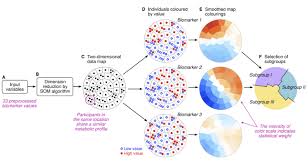Self-Organizing Neural Networks: Mimicking the Human Brain’s Learning Process
Neural networks have revolutionized the field of artificial intelligence by mimicking the complex structure and functionality of the human brain. Among the various types of neural networks, self-organizing neural networks stand out for their ability to learn and adapt without explicit supervision, much like how our brains organize and process information.
At the core of self-organizing neural networks is a concept known as unsupervised learning. Unlike supervised learning, where the network is trained on labeled data to make predictions, unsupervised learning allows the network to discover patterns and relationships in data without explicit guidance.
One of the key features of self-organizing neural networks is their ability to cluster similar data points together based on their intrinsic characteristics. This process, known as self-organization, enables the network to create meaningful representations of complex data sets in an unsupervised manner.
Self-organizing neural networks are particularly useful in tasks such as pattern recognition, data compression, and feature extraction. By organizing data into clusters or groups based on similarities, these networks can uncover hidden structures and relationships that may not be apparent through manual analysis.
One popular type of self-organizing neural network is the Kohonen Self-Organizing Map (SOM), which uses a competitive learning algorithm to map high-dimensional input data onto a lower-dimensional grid. The SOM learns to preserve the topological relationships present in the input data, making it a powerful tool for visualizing and exploring complex datasets.
In addition to their applications in data analysis and pattern recognition, self-organizing neural networks have also been used in various fields such as image processing, speech recognition, and bioinformatics. Their ability to autonomously learn from data and adapt to changing environments makes them versatile tools for solving a wide range of real-world problems.
As researchers continue to explore new advancements in artificial intelligence and machine learning, self-organizing neural networks remain a fascinating area of study. By harnessing the principles of self-organization found in nature, these networks offer a unique perspective on how we can build intelligent systems that learn and evolve on their own.
Understanding Self-Organizing Neural Networks: Key FAQs and Their Applications
- What is a self organizing network?
- What are the five stages in self Organising map?
- What are SOMs used for?
- What is self organization in neural network?
- What are self organizing maps used for?
- Why Kohonen network are called as self-organizing feature maps?
- What is self Organising neural network?
What is a self organizing network?
A self-organizing neural network, also known as a self-organizing map or SOM, is a type of artificial neural network that can learn and adapt without explicit supervision. Unlike traditional neural networks that rely on labeled data for training, self-organizing networks use unsupervised learning to organize and cluster input data based on similarities. By mimicking the human brain’s ability to self-organize information, these networks can uncover hidden patterns and structures in complex datasets, making them valuable tools for tasks such as pattern recognition, data visualization, and feature extraction.
What are the five stages in self Organising map?
In a Self-Organizing Map (SOM), there are five key stages that outline the process of how the network organizes and learns from input data. The first stage involves initializing the map by assigning random weights to each node in the network. Next, the competition stage comes into play, where input data is compared to the weights of nodes to determine the best matching unit. Following this is the cooperation stage, where neighboring nodes of the best matching unit are also updated to adapt to the input data. The adaptation stage focuses on adjusting the weights of nodes based on a learning rate that decreases over time. Finally, in the convergence stage, the SOM reaches a stable state where similar input data points are grouped together on the map, showcasing its self-organizing capabilities.
What are SOMs used for?
Self-Organizing Maps (SOMs), a type of self-organizing neural network, are widely used for a variety of applications in data analysis and visualization. One common use of SOMs is in clustering and organizing complex data sets to reveal underlying patterns and relationships. They are also employed in dimensionality reduction, where high-dimensional data is mapped onto a lower-dimensional grid while preserving the topological properties of the input space. Additionally, SOMs are utilized in tasks such as image recognition, speech processing, and anomaly detection, showcasing their versatility in solving real-world problems across different domains. Overall, SOMs serve as powerful tools for exploring and interpreting large datasets, making them valuable assets in the field of artificial intelligence and machine learning.
What is self organization in neural network?
Self-organization in a neural network refers to the process by which the network autonomously organizes and structures its connections and activations based on the input data it receives. Unlike traditional neural networks that require explicit supervision to learn patterns and relationships in data, self-organizing neural networks have the remarkable ability to identify similarities and group data points together without external guidance. This intrinsic capability allows the network to create meaningful representations of complex datasets, uncover hidden structures, and adapt to changing environments, making it a powerful tool for tasks such as pattern recognition, data clustering, and feature extraction.
What are self organizing maps used for?
Self-organizing maps, also known as SOMs, are widely used in various fields for tasks such as clustering, visualization, and dimensionality reduction. One of the key applications of self-organizing maps is in data analysis, where they are used to uncover hidden patterns and relationships in complex datasets. By organizing data into clusters based on similarities, SOMs can provide insights into the underlying structure of the data and help identify trends or anomalies. Additionally, self-organizing maps are commonly employed in image processing, speech recognition, and bioinformatics for tasks such as feature extraction and classification. Their ability to autonomously learn from data and create meaningful representations makes them valuable tools for exploring and understanding high-dimensional datasets in a visual and intuitive manner.
Why Kohonen network are called as self-organizing feature maps?
Kohonen networks are often referred to as self-organizing feature maps because of their unique ability to autonomously organize and represent complex data in a structured manner. The term “self-organizing” highlights the network’s capability to learn and adapt without external supervision, much like how the human brain organizes information through experience. By mapping high-dimensional input data onto a lower-dimensional grid, Kohonen networks create a visual representation of the input space where similar data points are clustered together. This process allows the network to extract and highlight important features or patterns present in the data, making it easier for users to interpret and analyze large datasets effectively.
What is self Organising neural network?
A self-organizing neural network, such as the Kohonen Self-Organizing Map (SOM), is a type of artificial neural network that utilizes unsupervised learning to organize and represent complex data in a meaningful way. Unlike traditional neural networks that rely on labeled data for training, self-organizing neural networks can autonomously discover patterns and relationships within input data without explicit guidance. Through a process of self-organization, these networks create clusters or groups of similar data points, allowing them to uncover hidden structures and capture the intrinsic characteristics of the data. This unique ability makes self-organizing neural networks valuable tools for tasks such as pattern recognition, data visualization, and feature extraction across various domains.




